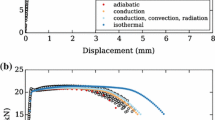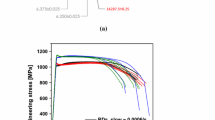Abstract
In the context of lessons learned from the second Sandia Fracture Challenge summit and observed shortcomings in our blind predictions, we revisit finite-element-based failure modeling of the Ti-6Al-4V sample. Anisotropy, rate effects, and thermal softening are used to model strength; damage mechanics is used to model failure; a non-local approach is used to mitigate mesh-dependence of results. We obtain upper and lower bound force versus crack-opening displacement curves and the means of the quantities of interest are found to meet the requirement of being within 10 % of the experimental results, but the predictions of more intensive quantities such as principal strain and temperature in the ligaments of the challenge sample are >10 %.













Similar content being viewed by others
References
Bai Y, Wierzbicki T (2010) Application of extended Mohr–Coulomb criterion to ductile fracture. Int J Fract 161(1):1–20. doi:10.1007/s10704-009-9422-8
Bao Y, Wierzbicki T (2004) On fracture locus in the equivalent strain and stress triaxiality space. Int J Mech Sci 46(1):81–98. doi:10.1016/j.ijmecsci.2004.02.006
Belnoue JP, Garnham B, Bache M, Korsunsky AM (2010) The use of coupled nonlocal damage-plasticity to predict crack growth in ductile metal plates. Eng Fract Mech 77(11):1721–1729. doi:10.1016/j.engfracmech.2010.03.001
Boyce BL, Kramer SLB, Bosilejvac TR, Corona E et al (2016) The second sandia fracture challenge: predictions of ductile failure under quasi-static and moderate-rate dynamic loading. Int J Fract. doi:10.1007/s10704-016-0089-7
Cazacu O, Plunkett B, Barlat F (2006) Orthotropic yield criterion for hexagonal closed packed metals. Int J Plast 22(7):1171–1194. doi:10.1016/j.ijplas.2005.06.001
Dorogoy A, Rittel D (2009) Determination of the Johnson–Cook material parameters using the SCS specimen. Exp Mech 49(6):881–885. doi:10.1007/s11340-008-9201-x
Giglio M, Manes A, Vigano F (2012) Ductile fracture locus of Ti–6al–4v titanium alloy. Int J Mech Sci 54(1):121–135. doi:10.1016/j.ijmecsci.2011.10.003
Hammer JT (2012) Plastic deformation and ductile fracture of Ti–6al–4v under various loading conditions. Masters’s Thesis, Department of Mechanical Engineering, The Ohio State University
Huang H, Xue L (2009) Prediction of slant ductile fracture using damage plasticity theory. Int J Press Vessels Pip 86(5):319–328
Karafillis A, Boyce M (1993) A general anisotropic yield criterion using bounds and a transformation weighting tensor. J Mech Phys Solids 41(12):1859–1886
Mason J, Rosakis A, Ravichandran G (1994) On the strain and strain rate dependence of the fraction of plastic work converted to heat: an experimental study using high speed infrared detectors and the Kolsky bar. Mech Mater 17(2):135–145
Meyers M (1994) Dynamic behavior of materials. A Wiley-interscience publication, Wiley, Hoboken
Odenberger EL (2009) Concepts for hot sheet metal forming of titanium alloys. Ph.D. thesis, Department of Applied Physics and Mechanical Engineering, Division of Solid Mechanics, Lulea University of Technology, Lula
Ortiz M, Simo J (1986) An analysis of a new class of integration algorithms for elastoplastic constitutive relations. Int J Numer Methods Eng 23(3):353–366
Pijaudier-Cabot G, Bazant Z (1987) Nonlocal damage theory. J Eng Mech 113(10):1512–1533
Rittel D, Wang Z (2008) Thermo-mechanical aspects of adiabatic shear failure of AM50 and Ti6al4v alloys. Mech Mater 40(8):629–635. doi:10.1016/j.mechmat.2008.03.002. http://linkinghub.elsevier.com/retrieve/pii/S0167663608000240
Simha CHM, Xu S, Tyson W (2014) Non-local phenomenological damage-mechanics-based modeling of the Drop-Weight Tear Test. Eng Fract Mech 118:66–82. doi:10.1016/j.engfracmech.2014.01.009
Taylor GI, Quinney H (1934) The latent energy remaining in a metal after cold working. Proc R Soc A413:307–326
Xue L (2007) Damage accumulation and fracture initiation in uncracked ductile solids subject to triaxial loading. Int J Solids Struct 44(16):5163–5181. doi:10.1016/j.ijsolstr.2006.12.026
Xue L, Wierzbicki T (2008) Ductile fracture initiation and propagation modeling using damage plasticity theory. Eng Fract Mech 75(11):3276–3293
Xue L, Wierzbicki T (2009) Numerical simulation of fracture mode transition in ductile plates. Int J Solids Struct 46(6):1423–1435
Author information
Authors and Affiliations
Corresponding author
Appendices
Appendix 1: Adiabatic localization strain
Following the procedure presented in chapter 15 of the text by Meyers (1994), the onset of localization can be estimated as follows. Using Eq. (3) in the plastic work equation, Eq. (4), and carrying out the integration, the increase in the homologous temperature can be shown to be
where the homologous temperature is defined as \(T^{*}=(T-T_{R})/(T_{M}-T_{R})\). Substituting for the homologus temperture in the strength model and setting \(d\bar{{\sigma }}/d\epsilon _{p}=0\) gives a non-linear equation which can be solved for the strain assuming a strain rate and using strength model constants from Table 1; solving the non-linear equation gives a strain of approximately 30 %.
Appendix 2: Cutting plane algorithm
We provide a brief description of the cutting-plane algorithm and derive the plastic strain increment, further details may be found in the article by Ortiz and Simo (1986). The computation of the damage is uncoupled from the plastic strain increment; this is tantamount to assuming that damage does not change during the timestep. The task of the subroutine at each time step is to update the stress tensor. At the same time, if the material is in the plastic state, the yield function (here, coupled with damage) has to be satisfied and the equivalent plastic strain has to be updated. In the following, we develop the plastic strain increment to be used in the cutting-plane algorithm. For simplicity, the transformation tensor, \(\varvec{{C}}\)is not shown here, and our computational implementation uses the diagonalization of the transformed stress tensor using the matrix of eigenvectors, see Eq. (14) of Karafillis and Boyce (1993). The yield function, \(\phi \), is linearized around the current values of the state variables (see Fig. 14) as
Invoking normality of plastic flow gives decrease in stress due to plastic flow as
where the elasticity tensor is \(\varvec{L}=2G\varvec{I} \,{+}\, (\mathcal {K} \,{-}\, \frac{{2}}{3}G)\varvec{1}\otimes \varvec{1}\), where G and \(\mathcal {{K}}\) are the shear and bulk modulus, respectively, and \(\varvec{r}=\partial \phi /\partial \varvec{\sigma }\). Expression for the strength differential \(d\bar{{\sigma }}\) reads
Plastic strain increment tensor is given by \(d\varvec{\epsilon }^{p}=d\lambda \partial \phi /\partial \varvec{{\sigma }}\), and using
\(\bar{{\sigma }}d\epsilon _{p}=\varvec{\sigma }d\varvec{\epsilon }^{p}\) gives
where \(\bar{{\sigma }}\) can be written in terms of F. Substituting into Eq. (17), and setting \(\phi =0\) gives an expression for \(\varDelta \lambda \)
Once the \(\varDelta \lambda \) is known, damage is computed and the stress state is advanced. The cutting-plane algorithm is well-known and no further elaboration is given here.
Rights and permissions
About this article
Cite this article
Simha, C.H.M., Williams, B.W. Modeling failure of Ti-6Al-4V using damage mechanics incorporating effects of anisotropy, rate and temperature on strength. Int J Fract 198, 101–115 (2016). https://doi.org/10.1007/s10704-016-0099-5
Received:
Accepted:
Published:
Issue Date:
DOI: https://doi.org/10.1007/s10704-016-0099-5





